An Observing System Simulation Experiment (OSSE) to Study the Impact of Ocean Surface Observation from the Micro Unmanned Robot Observation Network (MURON) on Tropical Cyclone Forecast
Abstract
:1. Introduction
2. The MURON Ocean Surface Observation
3. OSSE Framework—Nature Run and Simulated Observations
3.1. Case Description: Tropical Cyclone Haiyan (2013)
3.2. Configuration of the Nature Run
3.3. Simulation of Observation
4. OSSE Framework—Data Assimilation Experiment
4.1. Model Configuration
4.2. Data Assimilation Method
4.3. Data Assimilation Experimental Design
4.4. Choice of Observation Error (GSI_R, MURON_R)
5. Results
5.1. Impact of Assimilating MURON Observation on the Accuracy of the Analysis and Forecast
5.2. Diagnostics of the Impact of MURON Observation on the RI Forecast
5.3. Influence of MASS and WIND Observations of MURON
5.4. Impact of Moisture Control Variable
6. Summary and Discussion
Author Contributions
Funding
Institutional Review Board Statement
Informed Consent Statement
Data Availability Statement
Acknowledgments
Conflicts of Interest
References
- Lawrence, M.B.; National Hurricane Center Verification. NOAA. 1990. Available online: www.nhc.noaa.gov/verification/verify3.shtml (accessed on 30 March 2022).
- McAdie, C.J.; Lawrence, M.B. Improvements to tropical cyclone track forecasting in the Atlantic basin, 1970–98. Bull. Am. Meteorol. Soc. 2000, 81, 989–998. [Google Scholar] [CrossRef]
- Cangialosi, J.P. 2018 Hurricane Season. National Hurricane Center Forecast Verification Report. 2019. Available online: https://www.nhc.noaa.gov/verification/pdfs/Verification_2018.pdf (accessed on 30 March 2022).
- Rappaport, E.N.; Franklin, J.L.; Avila, L.A.; Baig, S.R.; Beven II, J.L.; Blake, E.S.; Burr, C.A.; Jiing, J.-G.; Juckins, C.A.; Knabb, R.D. Advances and challenges at the National Hurricane Center. Weather Forecast. 2009, 24, 395–419. [Google Scholar] [CrossRef] [Green Version]
- Cangialosi, J.P.; Franklin, J.L. National Hurricane Center Verification Report; Tropical Prediction Center, National Hurricane Center, National Center for Environmental Prediction, National Weather Center, NOAA: Miami, FL, USA, 2006; p. 57.
- Emanuel, K.A. Thermodynamic control of hurricane intensity. Nature 1999, 401, 665–669. [Google Scholar] [CrossRef]
- Zhang, F.; Sippel, J.A. Effects of moist convection on hurricane predictability. J. Atmos. Sci 2009, 66, 1944–1961. [Google Scholar] [CrossRef]
- Fang, J.; Zhang, F. Initial development and genesis of hurricane Dolly (2008). J. Atmos. Sci. 2010, 67, 655–672. [Google Scholar] [CrossRef]
- Fang, J.; Zhang, F. Evolution of multi-scale vortices in the development of Hurricane Dolly (2008). J. Atmos. Sci. 2011, 68, 103–122. [Google Scholar] [CrossRef] [Green Version]
- Taraphdar, S.; Mukhopadhyay, P.; Leung, L.R.; Zhang, F.; Abhilash, S.S.; Goswami, B.N. The role of moist processes in the intrinsic predictability of Indian Ocean cyclones. J. Geophys. Res. Atmos. 2014, 119, 8032–8048. [Google Scholar] [CrossRef]
- Bender, M.A.; Ginis, I.; Tuleya, R.; Thomas, B.; Marchok, T. The operational GFDL hurricane–ocean prediction system and a summary of its performance. Mon. Weather Rev. 2007, 135, 3965–3989. [Google Scholar] [CrossRef]
- Davis, C.; Wang, W.; Chen, S.S.; Chen, Y.; Corbosiero, K.; DeMaria, M.; Dudhia, J.; Holland, G.; Klemp, J.; Michalakes, J.; et al. Prediction of landfalling hurricanes with the Advanced Hurricane WRF model. Mon. Weather Rev. 2008, 136, 1990–2005. [Google Scholar] [CrossRef] [Green Version]
- Zhang, F.; Tao, D. Effects of vertical wind shear on the predictability of tropical cyclones. J. Atmos. Sci. 2013, 70, 975–983. [Google Scholar] [CrossRef]
- Black, P.G.; D’Asaro, E.A.; Drennan, W.M.; French, J.R.; Niiler, P.P.; Sanford, T.B.; Terrill, E.J.; Walsh, E.J.; Zhang, J.A. Air-sea exchange in hurricanes: Synthesis of observations from the Coupled Boundary Layer Air–Sea Transfer experiment. Bull. Am. Meteorol. Soc. 2007, 88, 357–374. [Google Scholar] [CrossRef] [Green Version]
- Price, J.F. Metrics of hurricane–ocean interaction: Vertically-integrated or vertically-averaged ocean temperature? Ocean Sci. 2009, 5, 351–368. [Google Scholar] [CrossRef] [Green Version]
- Zhang, J.A. Estimation of dissipative heating using low-level in situ aircraft observations in the hurricane boundary layer. J. Atmos. Sci. 2010, 67, 1853–1862. [Google Scholar] [CrossRef] [Green Version]
- Kepert, J.D. Choosing a boundary layer parameterization for tropical cyclone modeling. Mon. Weather Rev. 2012, 140, 1427–1445. [Google Scholar] [CrossRef] [Green Version]
- Green, B.W.; Zhang, F. Impacts of air–sea flux parameterizations on the intensity and structure of tropical cyclones. Mon. Weather Rev. 2013, 141, 2308–2324. [Google Scholar] [CrossRef] [Green Version]
- Ricchi, A.; Miglietta, M.M.; Barbariol, F.; Benetazzo, A.; Bergamasco, A.; Bonaldo, D.; Cassardo, C.; Falcieri, F.M.; Modugno, G.; Russo, A.; et al. Sensitivity of a Mediterranean Tropical-Like Cyclone to Different Model Configurations and Coupling Strategies. Atmosphere 2017, 8, 92. [Google Scholar] [CrossRef] [Green Version]
- Nguyen, V.S.; Smith, R.K.; Montgomery, M.T. Tropical-cyclone intensification and predictability in three dimensions. Q. J. R. Meteorol. Soc. 2008, 134, 563–582. [Google Scholar]
- Wang, H.; Wang., Y. A numerical study of Typhoon Megi (2010). Part I: Rapid intensification. Mon. Weather Rev. 2014, 142, 29–48. [Google Scholar] [CrossRef]
- Emanuel, K.; DesAutels, C.; Holloway, C.; Korty, R. Environmental control of tropical cyclone intensity. J. Atmos. Sci. 2004, 61, 843–858. [Google Scholar] [CrossRef]
- Zou, X.; Qin, Z.; Weng, F. Improved coastal precipitation forecasts with direct assimilation of GOES-11/12 imager radiances. Mon. Weather Rev. 2011, 139, 3711–3729. [Google Scholar] [CrossRef] [Green Version]
- Zou, X.; Qin, Z.; Zheng, Y. Improved tropical storm forecasts with GOES-13/15 imager radiance assimilation and asymmetric vortex initialization in HWRF. Mon. Weather Rev. 2015, 143, 2485–2505. [Google Scholar] [CrossRef]
- Chelton, D.B.; Freilich, M.H.; Sienkiewicz, J.M.; von Ahn, J.M. 2006: On the use of QuikSCAT Scatterometer measurements of surface winds for marine weather prediction. Mon. Weather Rev. 2006, 134, 2055–2071. [Google Scholar] [CrossRef]
- Brennan, M.J.; Hennon, C.C.; Knabb, R.D. The operational use of QuikSCAT ocean surface vector winds at the National Hurricane Center. Weather Forecast. 2009, 24, 621–645. [Google Scholar] [CrossRef] [Green Version]
- Desbiolles, F.; Bentamy, A.; Blanke, B.; Roy, C.; Mestas-Nuñez, A.M.; Grodsky, S.A.; Herbette, S.; Cambon, G.; Maes, C. Two decades (1992–2012) of surface wind analyses based on satellite scatterometer observations. J. Mar. Syst. 2017, 168, 38–56. [Google Scholar] [CrossRef] [Green Version]
- Ruf, C.S.; Atlas, R.; Chang, P.S.; Clarizia, M.P.; Garrison, J.L.; Gleason, S.; Katzberg, S.J.; Jelenak, Z.; Johnson, J.T.; Majumdar, S.J.; et al. New ocean winds satellite mission to probe hurricanes and tropical convection. Bull. Am. Meteorol. Soc. 2016, 97, 385–395. [Google Scholar] [CrossRef]
- Zhang, S.; Pu, Z.; Posselt, D.J.; Atlas, R. Impact of CYGNSS ocean surface wind speeds on numerical simulations of a hurricane in observing system simulation experiments. J. Atmos. Ocean. Technol. 2017, 34, 375–383. [Google Scholar] [CrossRef]
- Ruf, C.S.; Chew, C.; Lang, T.; Morris, M.G.; Nave, K.; Ridley, A.; Balasubramaniam, R. New paradigm in Earth environmental monitoring with the CYGNSS small satellite constellation. Sci. Rep. 2018, 8, 8782. [Google Scholar] [CrossRef] [Green Version]
- Masutani, M.; Andersson, E.; Terry, J.; Reale, O.; Jusem, J.C.; Riishojgaard, L.P.; Schlatter, T.; Stoffelen, A.; Woollen, J.; Lord, S.; et al. Progress in Joint OSSEs: A new nature run and international collaboration. In Proceedings of the 12th Conference on Integrated Observing and Assimilation Systems for Atmospheres, Oceans, and Land Surface (IOAS-AOLS), New Orleans, LA, USA, 20–24 January 2008; Available online: http://ams.confex.com/ams/pdfpapers/124080.pdf (accessed on 30 March 2022).
- Masutani, M.; Woollen, J.S.; Lord, S.J.; Emmitt, G.D.; Kleespies, T.J.; Wood, S.A.; Greco, S.; Sun, H.; Terry, J.; Kapoor, V.; et al. Observing system simulation experiments at the National Centers for Environmental Prediction. J. Geophys. Res. 2010, 115, D07101. [Google Scholar] [CrossRef] [Green Version]
- Shu, S.; Zhang, F. Influence of equatorial waves on the genesis of Super Typhoon Haiyan (2013). J. Atmos. Sci. 2015, 72, 4591–4613. [Google Scholar] [CrossRef] [Green Version]
- Evans, A.D.; Falvey, R.J. Annual Joint Typhoon Warning Center Tropical Cyclone Report; JTWC: Hancock County, MI, USA, 2013; p. 118. [Google Scholar]
- Chen, Z.; Zhang, C.; Huang, Y.; Feng, Y.; Zhong, S.; Dai, G.; Xu, D.; Yang, Z. Track of Super Typhoon Haiyan predicted by a typhoon model for the South China Sea. J. Meteorol. Res. 2014, 28, 510–523. [Google Scholar] [CrossRef]
- Lander, M.; Guard, C.; Camargo, S.J. Tropical cyclones, super-typhoon Haiyan, in State of the Climate in 2013. Bull. Am. Meteorol. Soc. 2014, 95, S112–S114. [Google Scholar]
- Lin, I.-I.; Pun, I.-F.; Lien, C.-C. “Category-6” supertyphoon Haiyan in global warming hiatus: Contribution from subsurface ocean warming. Geophys. Res. Lett. 2014, 41, 8547–8553. [Google Scholar] [CrossRef]
- Huang, H.-C.; Boucharel, J.; Lin, I.-I.; Jin, F.-F.; Lien, C.-C.; Pun, I.-F. Air-sea fluxes for Hurricane Patricia (2015): Comparison with supertyphoon Haiyan (2013) and under different ENSO conditions. J. Geophys. Res. Oceans 2017, 122, 6076–6089. [Google Scholar] [CrossRef]
- Skamarock, W.C.; Klemp, J.B.; Dudhia, J.; Gill, D.O.; Barker, D.; Duda, M.G.; Huang, X.-Y.; Wang, W.; Powers, J.G. 2008: A Description of the Advanced Research WRF Version 3; NCAR Tech. Note, NCAR/TN-4751STR; NCAR: Boulder, CO, USA, 2008; p. 113. [Google Scholar] [CrossRef]
- Lim, K.S.; Hong, S. Development of an Effective Double-Moment Cloud Microphysics Scheme with Prognostic Cloud Condensation Nuclei (CCN) for Weather and Climate Models. Mon. Weather Rev. 2010, 138, 1587–1612. [Google Scholar] [CrossRef] [Green Version]
- Kain, J.S.; Fritsch, J.M. A one-dimensional entraining/detraining plume model and its application in convective parameterization. J. Atmos. Sci. 1990, 47, 2784–2802. [Google Scholar] [CrossRef] [Green Version]
- Kain, J.S. The Kain–Fritsch convective parameterization: An update. J. Appl. Meteorol. 2004, 43, 170–181. [Google Scholar] [CrossRef] [Green Version]
- Hong, S.-Y.; Noh, Y.; Dudhia, J. A new vertical diffusion package with an explicit treatment of entrainment processes. Mon. Weather Rev. 2006, 134, 2318–2341. [Google Scholar] [CrossRef] [Green Version]
- Hong, S.-Y. A new stable boundary layer mixing scheme and its impact on the simulated East Asian summer monsoon. Q. J. R. Meteorol. Soc. 2010, 136, 1481–1496. [Google Scholar] [CrossRef]
- Chen, F.; Dudhia, J. Coupling an advanced land surface–hydrology model with the Penn State–NCAR MM5 modeling system. Part I: Model implementation and sensitivity. Mon. Weather Rev. 2001, 129, 569–585. [Google Scholar] [CrossRef] [Green Version]
- Mlawer, E.J.; Taubman, S.J.; Brown, P.D.; Iacono, M.J.; Clough, S.A. Radiative transfer for inhomogeneous atmospheres: RRTM, a validated correlated-k model for the longwave. J. Geophys. Res. 1997, 102, 16663–16682. [Google Scholar] [CrossRef] [Green Version]
- Iacono, M.J.; Delamere, J.S.; Mlawer, E.J.; Shephard, M.W.; Clough, S.A.; Collins, W.D. Radiative forcing by long-lived greenhouse gases: Calculations with the AER radiative transfer models. J. Geophys. Res. 2008, 113, D13103. [Google Scholar] [CrossRef]
- Nolan, D.S.; Zhang, J.A.; Stern, D.P. Evaluation of planetary boundary layer parameterizations in tropical cyclones by comparison of in situ observations and high-resolution simulations of Hurricane Isabel (2003), Part I: Initialization, maximum winds, and the outer-core boundary layer. Mon. Weather Rev. 2009, 137, 3651–3674. [Google Scholar] [CrossRef]
- Nolan, D.S.; Atlas, R.; Bhatia, K.T.; Bucci, L.R. Development and validation of a hurricane nature run using the Joint OSSE nature run and the WRF model. J. Adv. Earth Model. Syst. 2013, 5, 382–405. [Google Scholar] [CrossRef]
- Stauffer, D.R.; Seaman, N.L. Use of four-dimensional data assimilation in a limited-area mesoscale model, Part I: Experiments with synoptic-scale data. Mon. Weather Rev. 1990, 118, 1250–1277. [Google Scholar] [CrossRef] [Green Version]
- Shao, H.; Derber, J.; Huang, X.Y.; Hu, M.; Newman, K.; Stark, D.; Lueken, M.; Zhou, C.; Nance, L.; Kuo, Y.H.; et al. Bridging research to operations transitions: Status and plans of community GSI. Bull. Am. Meteorol. Soc. 2016, 97, 1427–1440. [Google Scholar] [CrossRef]
- Hu, M.; Ge, G.; Zhou, C.; Stark, D.; Shao, H.; Newman, K.; Beck, J.; Zhang, X. Grid-Point Statistical Interpolation (GSI) User’s Guide Version 3.7. Developmental Testbed Center; p. 147. Available online: http://www.dtcenter.org/com-GSI/users/docs/index.php (accessed on 30 March 2022).
- Degelia, S.K.; Wang, X.; Stnsrud, D.J. An evaluation of the impact of assimilating AERI retrievals, kinematic profilers, rawinsondes, and surface observations on a forecast of a nocturnal convection initiation event during the PECAN field campaign. Mon. Weather Rev. 2019, 147, 2739–2764. [Google Scholar] [CrossRef]
- Smith, R.K. The role of cumulus convection in hurricanes and its representation in hurricane models. Rev. Geophys. 2000, 38, 465–489. [Google Scholar] [CrossRef]
- Nasrollahi, N.; AghaKouchak, A.; Li, J.; Gao, X.; Hsu, K.; Sorooshian, S. Assessing the impacts of different WRF precipitation physics in hurricane simulations. Weather Forecast. 2012, 27, 1003–1016. [Google Scholar] [CrossRef]
- Biswas, M.K.; Bernardet, L.; Dudhia, J. Sensitivity of hurricane forecasts to cumulus parameterizations in the HWRF model. Geophys. Res. Lett. 2014, 41, 9113–9119. [Google Scholar] [CrossRef]
- Mellor, G.L.; Yamada, T. Development of a turbulence closure model for geophysical fluid problems. Rev. Geophys. 1982, 20, 851–875. [Google Scholar] [CrossRef] [Green Version]
- Janjic, Z.I. The step-mountain coordinate: Physical package. Mon. Wea. Rev. 1990, 118, 1429–1443. [Google Scholar] [CrossRef]
- Janjic, Z.I. The step-mountain Eta coordinate model: Further developments of the convection, viscous layer, and turbulence closure schemes. Mon. Wea. Rev. 1994, 122, 927–945. [Google Scholar] [CrossRef] [Green Version]
- Janjic, Z.I. Nonsingular Implementation of the Mellor-Yamada Level 2.5 Scheme in the NCEP Meso Model; NOAA/NWS/NCEP Office Note 437; NOAA Science Center: Silver Spring, MD, USA, 2001; p. 61.
- Whitaker, J.S.; Hamill, T.M. Ensemble data assimilation without perturbed observations. Mon. Weather Rev. 2002, 130, 1913–1924. [Google Scholar] [CrossRef]
- Wu, C.; Lien, G.; Chen, J.; Zhang, F. Assimilation of tropical cyclone track and structure based on the Ensemble Kalman Filter (EnKF). J. Atmos. Sci. 2010, 67, 3806–3822. [Google Scholar] [CrossRef]
- Meng, Z.; Zhang, F. Limited-area ensemble-based data assimilation. Mon. Weather Rev. 2011, 139, 2025–2045. [Google Scholar] [CrossRef] [Green Version]
- Jung, B.-J.; Kim, H.M.; Zhang, F.; Wu, C.-C. Effect of targeted dropsonde observations and best track data on the track forecasts of Typhoon Sinlaku (2008) using an ensemble Kalman filter. Tellus A 2012, 64, 14984. [Google Scholar] [CrossRef]
- Lu, X.; Wang, X.; Tong, M.; Tallapragada, V. GSI-based, continuously cycled, dual-resolution hybrid ensemble-variational data assimilation system for HWRF: System description and experiments with Edouard (2014). Mon. Weather Rev. 2017, 145, 4877–4898. [Google Scholar] [CrossRef]
- Lu, X.; Wang, X.; Li, Y.; Tong, M.; Ma, X. GSI-based ensemble-variational hybrid data assimilation for HWRF for hurricane initialization and prediction: Impact of various error covariances for airborne radar observation assimilation. Q. J. R. Meteorol. Soc. 2017, 143, 223–239. [Google Scholar] [CrossRef]
- Wang, X.; Parrish, D.; Kleist, D.; Whitaker, J. GSI 3DVar-based ensemble–variational hybrid data assimilation for NCEP Global Forecast System: Single-resolution experiments. Mon. Weather Rev. 2013, 141, 4098–4117. [Google Scholar] [CrossRef]
- Wang, X.; Lei, T. GSI-based four-dimensional ensemble–variational (4DEnsVar) data assimilation: Formulation and single-resolution experiments with real data for NCEP Global Forecast System. Mon. Weather Rev. 2014, 142, 3303–3325. [Google Scholar] [CrossRef]
- Gaspari, G.; Cohn, S.E. Construction of correlation functions in two and three dimensions. Q. J. R. Meteorol. Soc. 1999, 125, 723–757. [Google Scholar] [CrossRef]
- Anderson, J.L.; Anderson, S.L. A Monte Carlo implementation of the nonlinear filtering problem to produce ensemble assimilations and forecasts. Mon. Weather Rev. 1999, 127, 2741–2758. [Google Scholar] [CrossRef]
- Whitaker, J.S.; Hamill, T.M. Evaluating methods to account for system errors in ensemble data assimilation. Mon. Weather Rev. 2012, 140, 3078–3089. [Google Scholar] [CrossRef]
- Torn, R.D.; Hakim, G.J.; Snyder, C. Boundary conditions for limited area ensemble Kalman filters. Mon. Weather Rev. 2006, 134, 2490–2502. [Google Scholar] [CrossRef]
- Wang, X.; Barker, D.M.; Snyder, C.; Hamill, T.M. A hybrid ETKF–3DVAR data assimilation scheme for the WRF model. Part I: Observing system simulation experiment. Mon. Weather Rev. 2008, 136, 5116–5131. [Google Scholar] [CrossRef] [Green Version]
- Desroziers, G.; Berre, L.; Chapnik, B.; Poli, P. Diagnosis of observation, background and analysis-error statistics in observation space. Q. J. R. Meteorol. Soc. 2005, 131, 3385–3396. [Google Scholar] [CrossRef]
- Wang, X.; Bishop, C.H. A comparison of breeding and en-semble transform Kalman filter ensemble forecast schemes. J. Atmos. Sci. 2003, 60, 1140–1158. [Google Scholar] [CrossRef]
- Cione, J.J.; Black, P.G.; Houston, S.H. Surface observations in the hurricane environment. Mon. Weather Rev. 2000, 128, 1550–1561. [Google Scholar] [CrossRef]
- Shapiro, L.J. The asymmetric boundary layer flow under a translating hurricane. J. Atmos. Sci. 1983, 40, 1984–1998. [Google Scholar] [CrossRef] [Green Version]
- Kepert, J.D. Observed boundary layer wind structure and balance in the hurricane core. Part I: Hurricane Georges. J. Atmos. Sci. 2006, 63, 2169–2193. [Google Scholar] [CrossRef]
- Schwendike, J.; Kepert, J.D. The boundary layer winds in Hurricane Danielle (1998) and Isabel (2003). Mon. Weather Rev. 2008, 136, 3168–3191. [Google Scholar] [CrossRef]
- DeMaria, M. The effect of vertical shear on tropical cyclone intensity change. J. Atmos. Sci. 1996, 53, 2076–2088. [Google Scholar] [CrossRef] [Green Version]
- Chen, S.S.; Price, J.F.; Zhao, W.; Donelan, M.A.; Walsh, E.J. The CBLAST-Hurricane program and the next generation fully coupled atmosphere–wave–ocean models for hurricane research and prediction. Bull. Am. Meteorol. Soc. 2007, 88, 311–317. [Google Scholar] [CrossRef]
- Franklin, J.L.; Black, M.L.; Valde, K. GPS dropwindsonde wind profiles in hurricanes and their operational implications. Weather Forecast. 2003, 18, 32–44. [Google Scholar] [CrossRef]
- Zhang, J.A.; Rogers, R.F.; Nolan, D.S.; Marks, F.D. On the characteristic height scales of the hurricane boundary layer. Mon. Weather Rev. 2011, 139, 2523–2535. [Google Scholar] [CrossRef]
- Wroe, D.R.; Barnes, G.M. Inflow layer energetics of Hurricane Bonnie (1998) near landfall. Mon. Weather Rev. 2003, 131, 1600–1612. [Google Scholar] [CrossRef]
- Gray, W.M. Global view of the origin of tropical disturbances and storms. Mon. Weather Rev. 1968, 96, 669–700. [Google Scholar] [CrossRef]
- Houze, R.A.; Lee, W.; Bell, M.M. Convective contribution to the genesis of Hurricane Ophelia (2005). Mon. Weather Rev. 2009, 137, 2778–2800. [Google Scholar] [CrossRef]
- Wu, C.; Chou, K.; Wang, Y.; Kuo, Y. Tropical cyclone initialization and prediction based on four-dimensional variational data assimilation. J. Atmos. Sci. 2006, 63, 2383–2395. [Google Scholar] [CrossRef]
- Atkinson, G.D.; Holliday, C.R. Tropical cyclone minimum sea level pressure-maximum sustained wind relationship for western North Pacific. Mon. Weather Rev. 1977, 105, 421–427. [Google Scholar] [CrossRef] [Green Version]
- Holland, G. A revised hurricane pressure–wind model. Mon. Weather Rev. 2008, 136, 3432–3445. [Google Scholar] [CrossRef] [Green Version]
- Kleist, D.T.; Parrish, D.F.; Derber, J.C.; Treadon, R.; Errico, R.M.; Yang, R. Improving incremental balance in the GSI 3DVAR analysis system. Mon. Weather Rev. 2009, 137, 1046–1060. [Google Scholar] [CrossRef]
- Piccolo, C. Growth of forecast errors from covariances modeled by 4DVAR and ETKF methods. Mon. Weather Rev. 2011, 139, 1505–1518. [Google Scholar] [CrossRef]
- Wheatley, D.M.; Stensrud, D.J. The impact of assimilating surface pressure observations on severe weather events in a WRF mesoscale ensemble system. Mon. Weather Rev. 2010, 138, 1673–1694. [Google Scholar] [CrossRef]
- Dee, D.P.; da Silva, A.M. The choice of variable for atmospheric moisture analysis. Mon. Weather Rev. 2003, 131, 155–171. [Google Scholar] [CrossRef] [Green Version]
- Gustafsson, N.; Thorsteinsson, S.; Stengel, M.; Holm, E. Use of a nonlinear pseudo-relative humidity variable in a multivariate formulation of moisture analysis. Q. J. R. Meteorol. Soc. 2011, 137, 1004–1018. [Google Scholar] [CrossRef]
- Takacs, L.L.; Suárez, M.J.; Todling, R. Maintaining atmospheric mass and water balance in reanalyses. Quart. J. Q. J. R. Meteorol. Soc. 2016, 142, 1565–1573. [Google Scholar] [CrossRef] [Green Version]
- Yang, S.; Kalnay, E.; Hunt, B. Handling nonlinearity in an ensemble Kalman filter: Experiments with the three-variable Lorenz model. Mon. Weather Rev. 2012, 140, 2628–2646. [Google Scholar] [CrossRef]
- Bishop, C.H. The GIGG–EnKF: Ensemble Kalman filtering for highly skewed non-negative uncertainty distributions. Q. J. R. Meteorol. Soc. 2016, 142, 1395–1412. [Google Scholar] [CrossRef]
- Snyder, C.; Bengtsson, T.; Morzfeld, M. Performance bounds for particle filters using optimal proposal. Mon. Weather Rev. 2015, 143, 4750–4761. [Google Scholar] [CrossRef]
- Van Leeuwen, P.J. Particle filtering in geophysical systems. Mon. Weather Rev. 2009, 137, 4089–4114. [Google Scholar] [CrossRef]
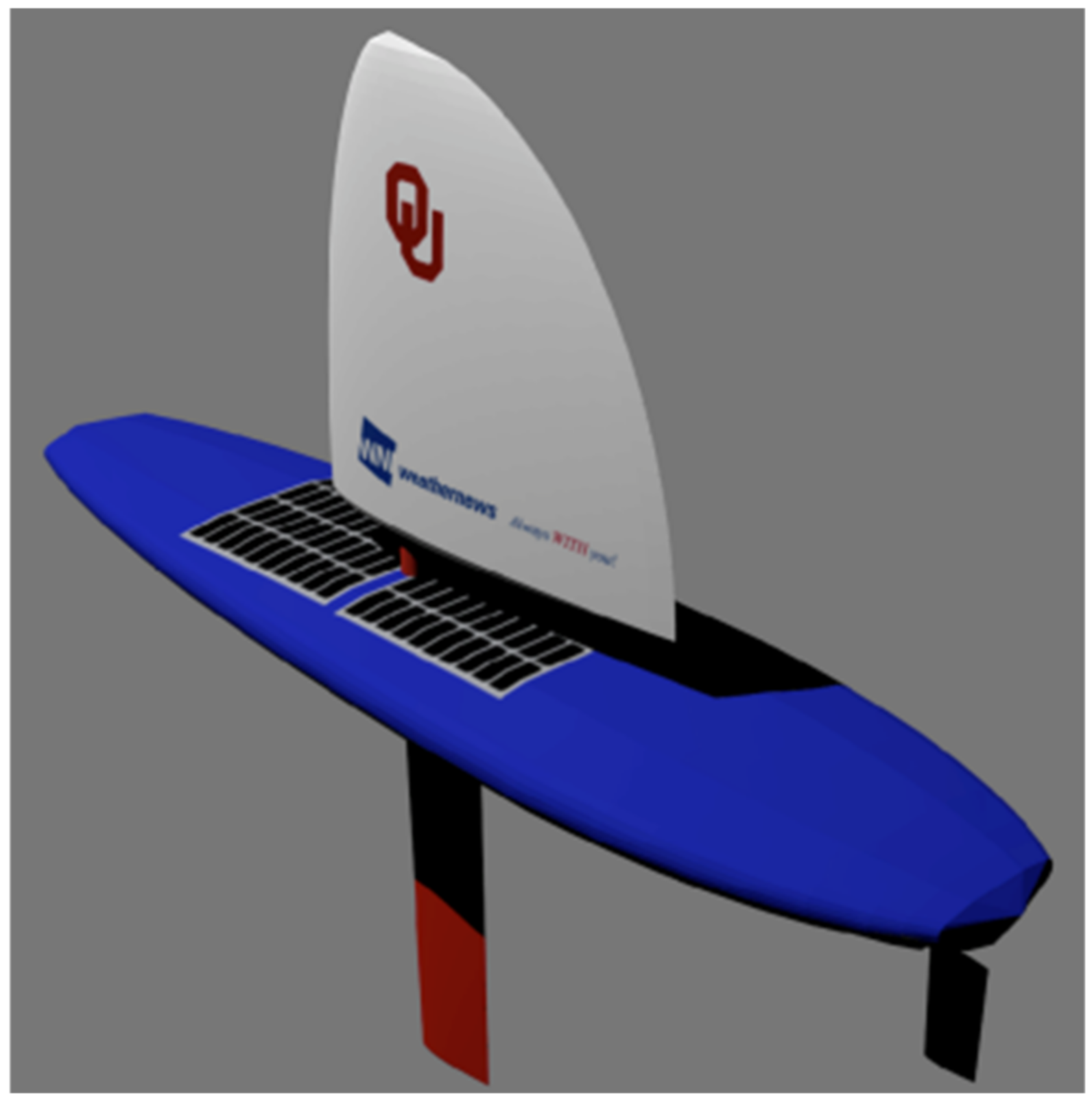
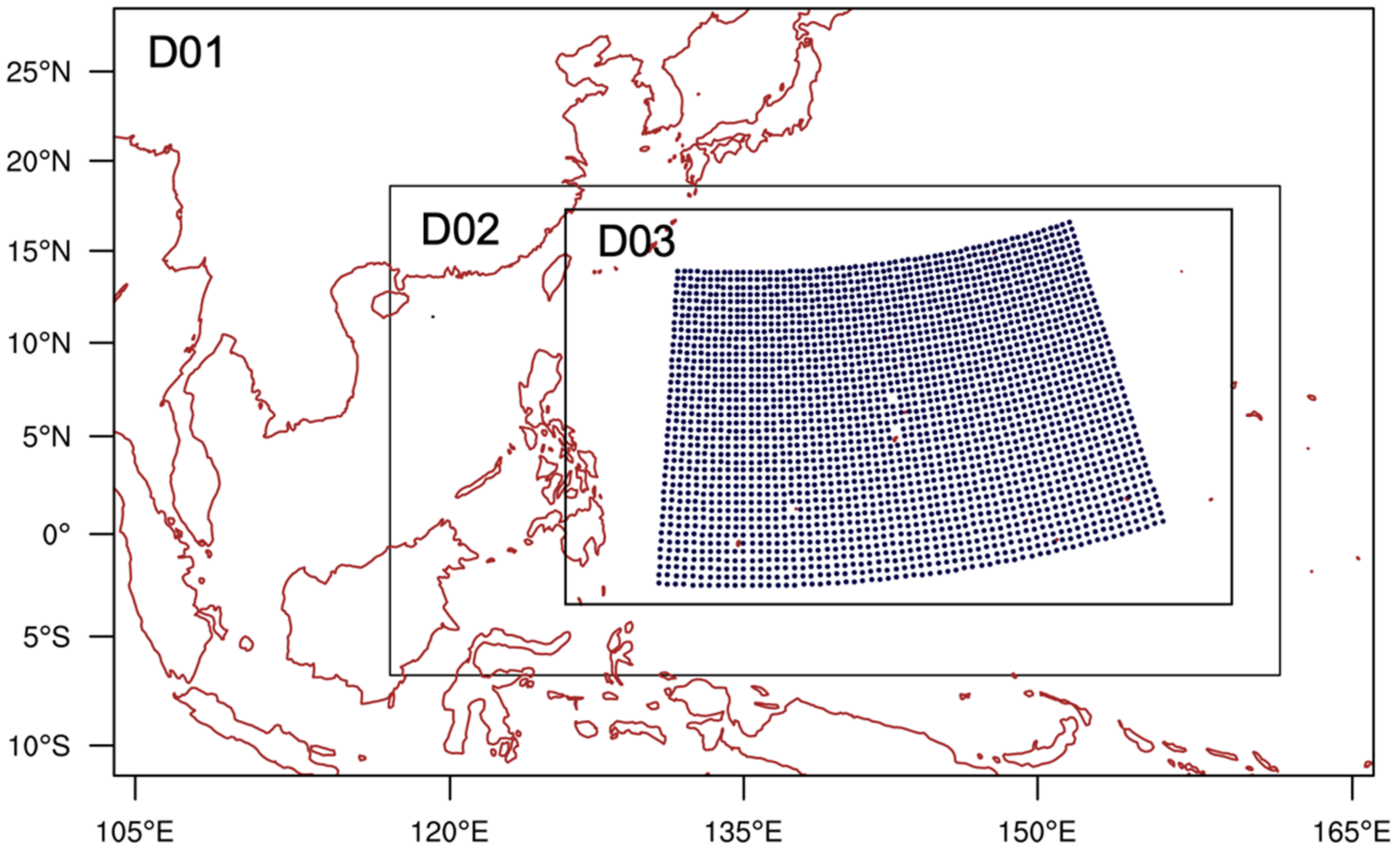

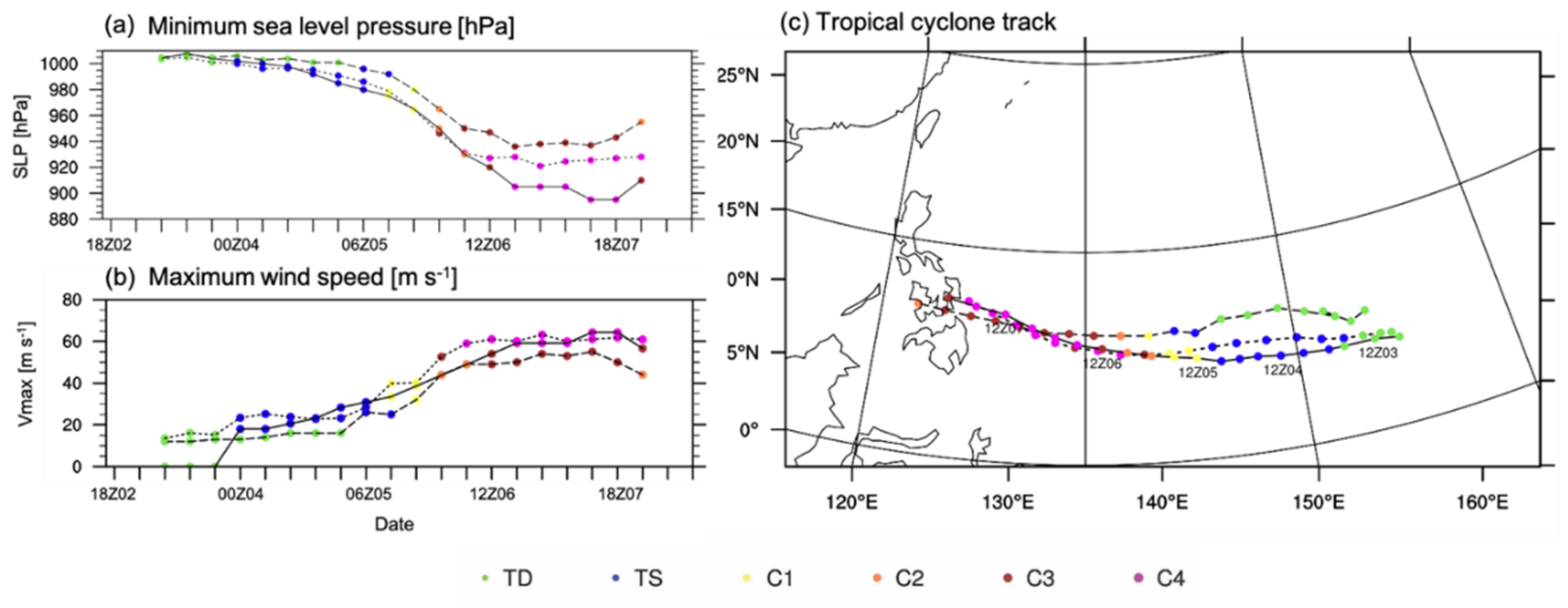
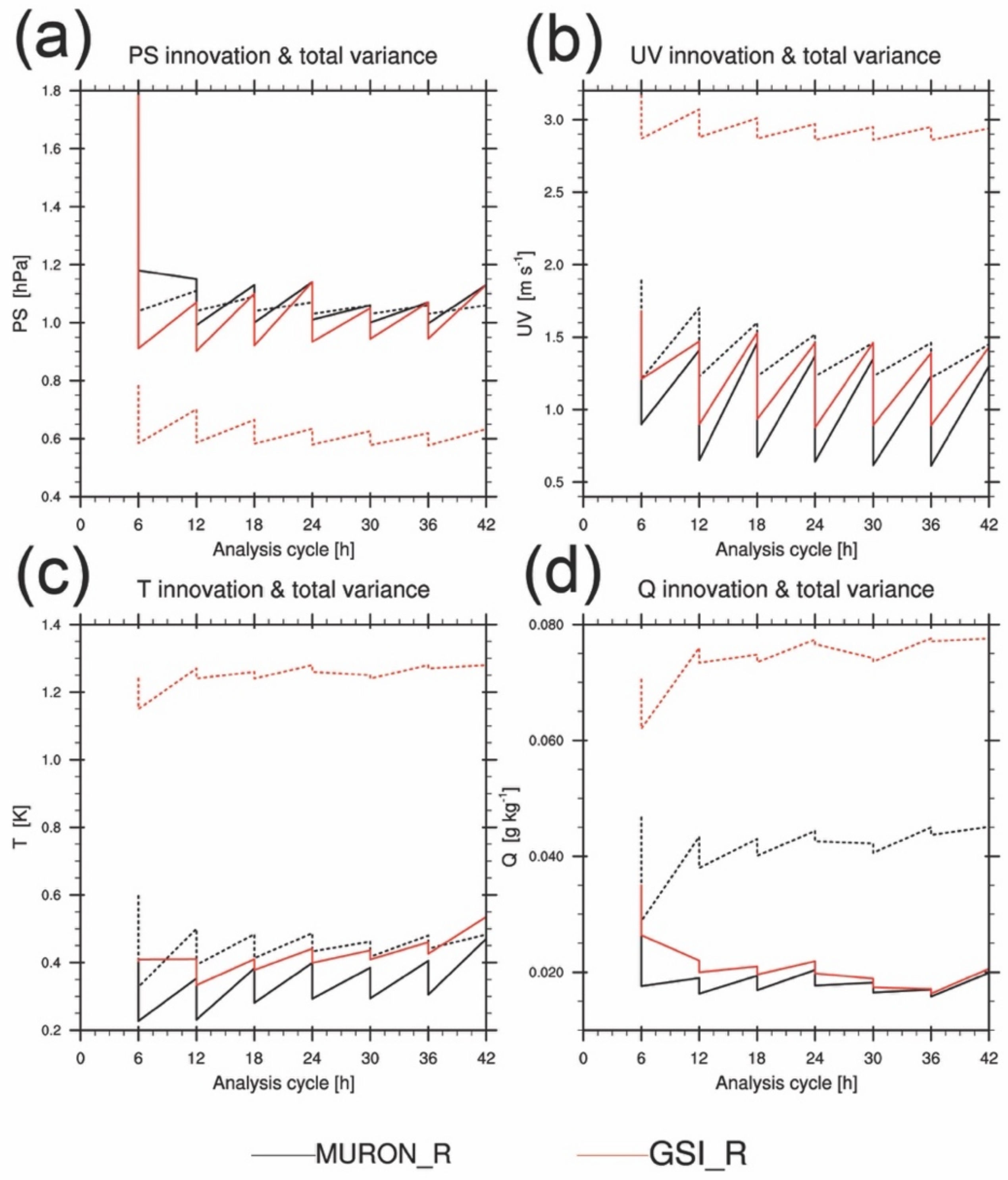
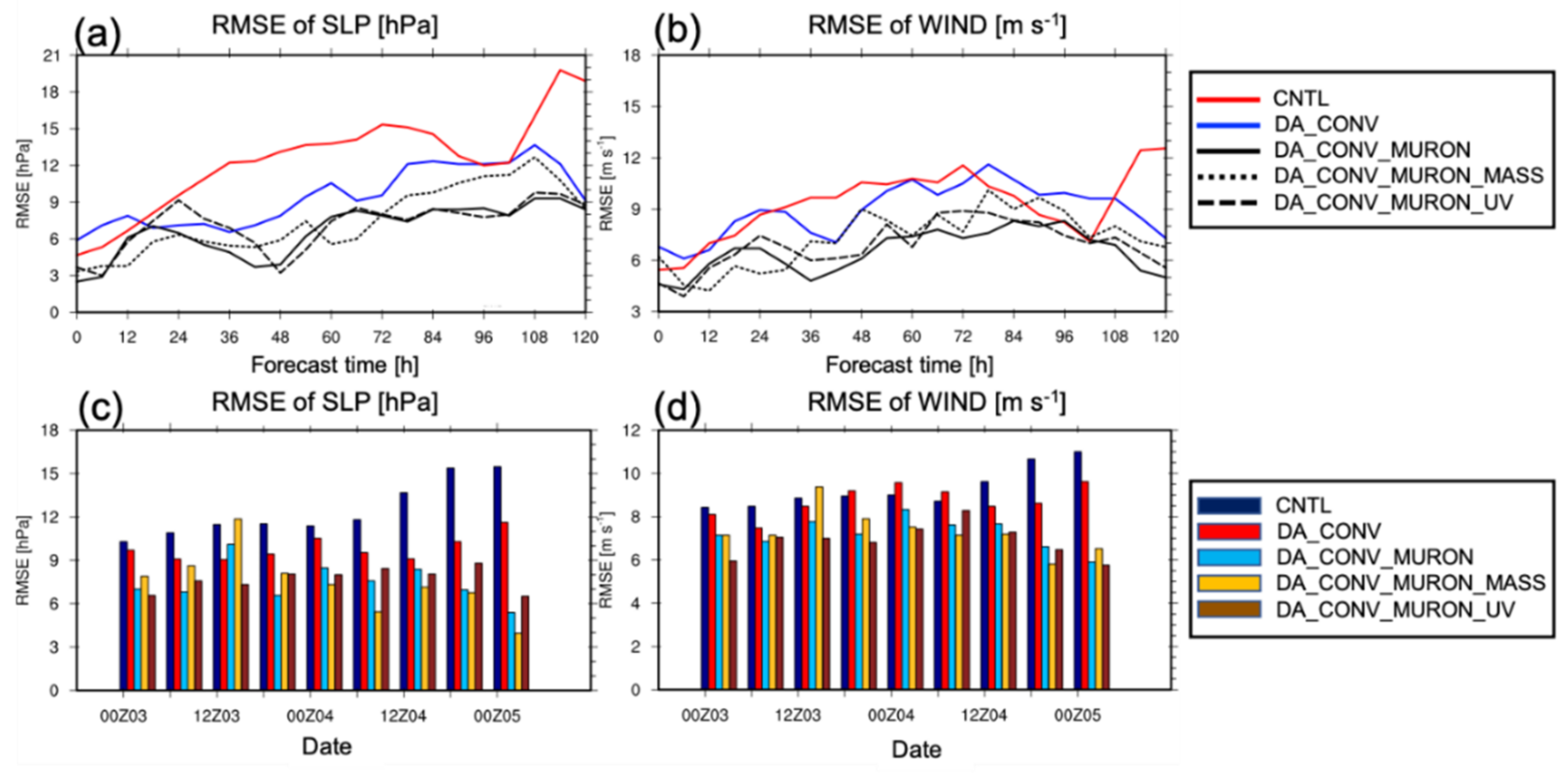

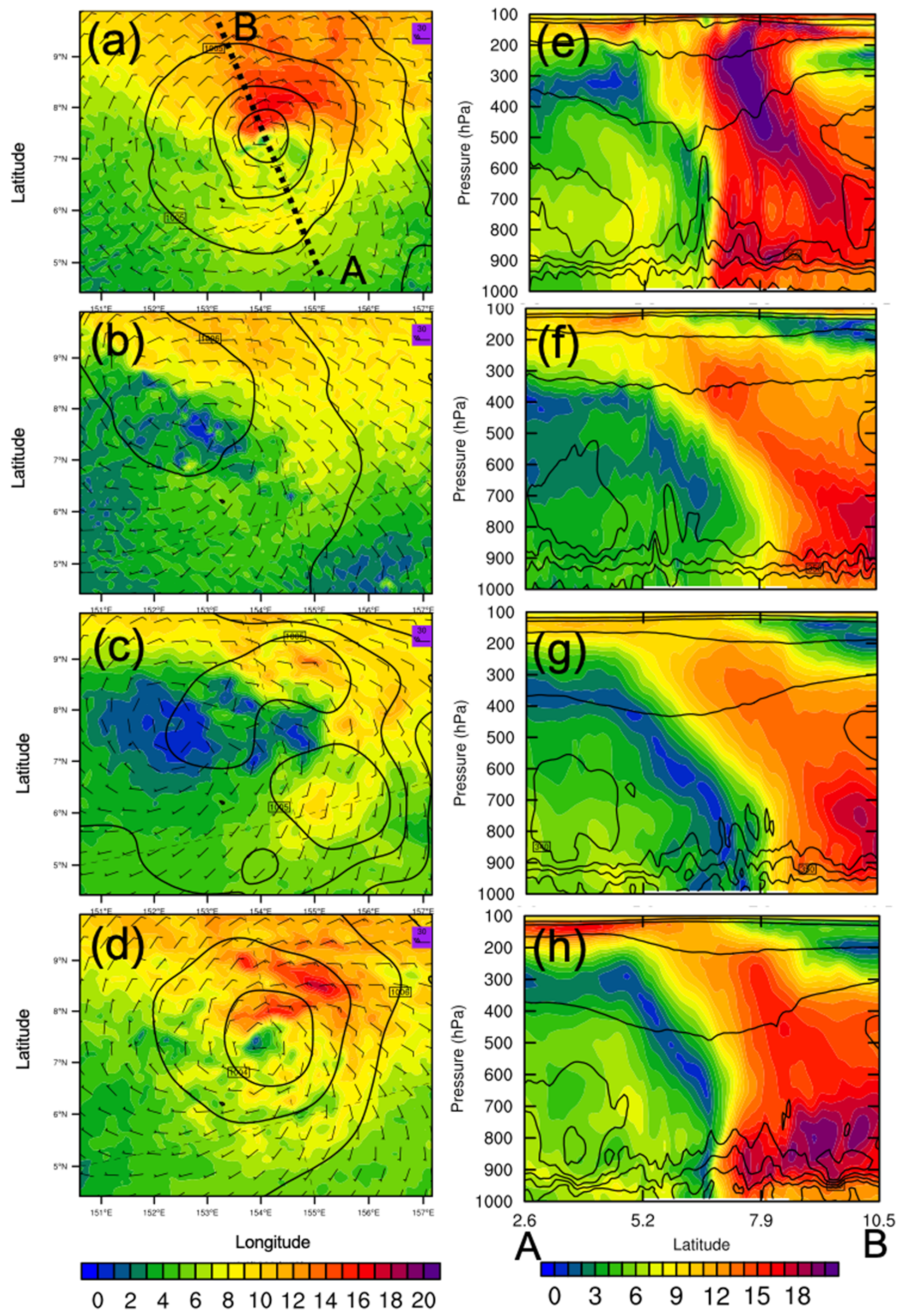

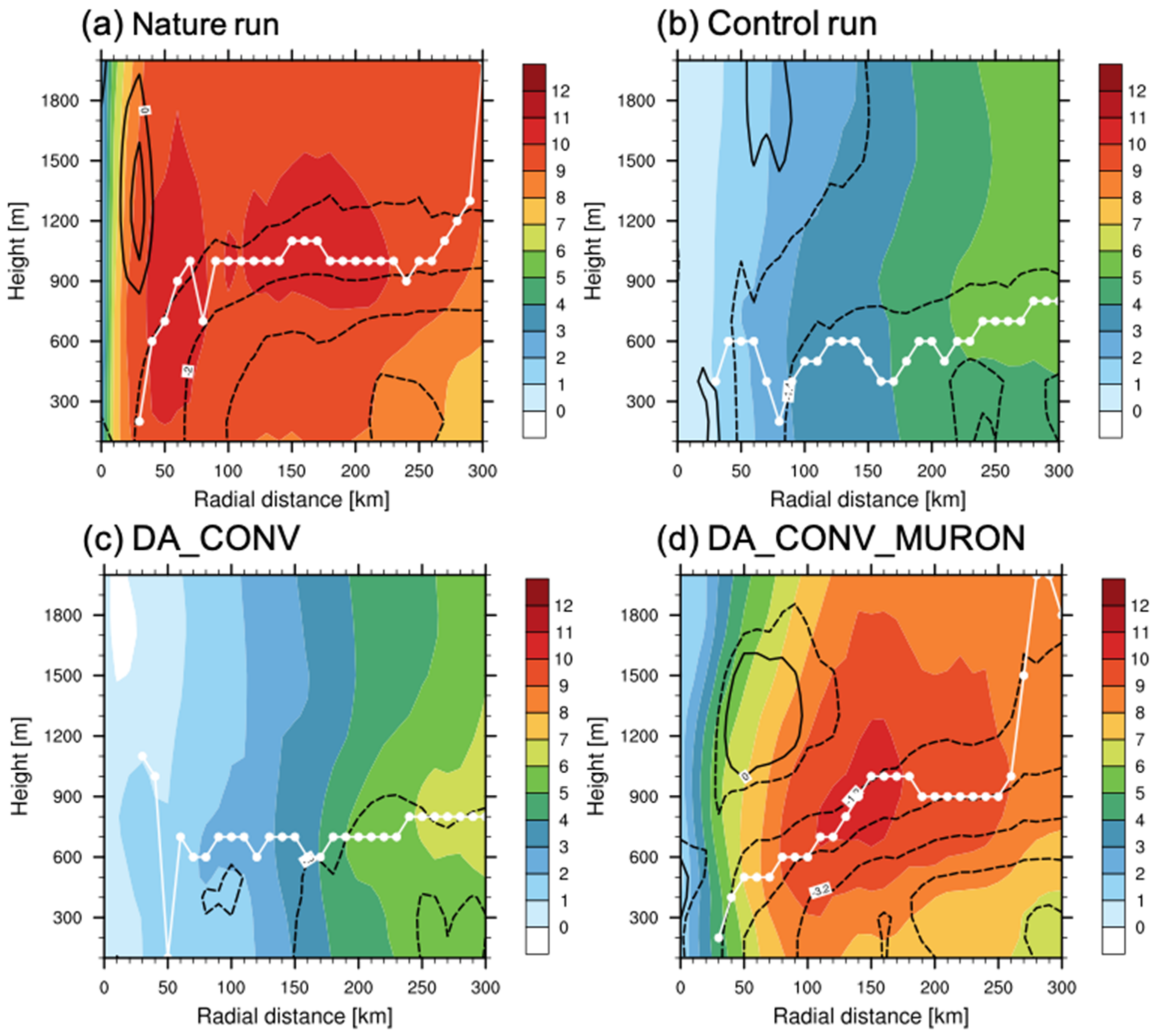
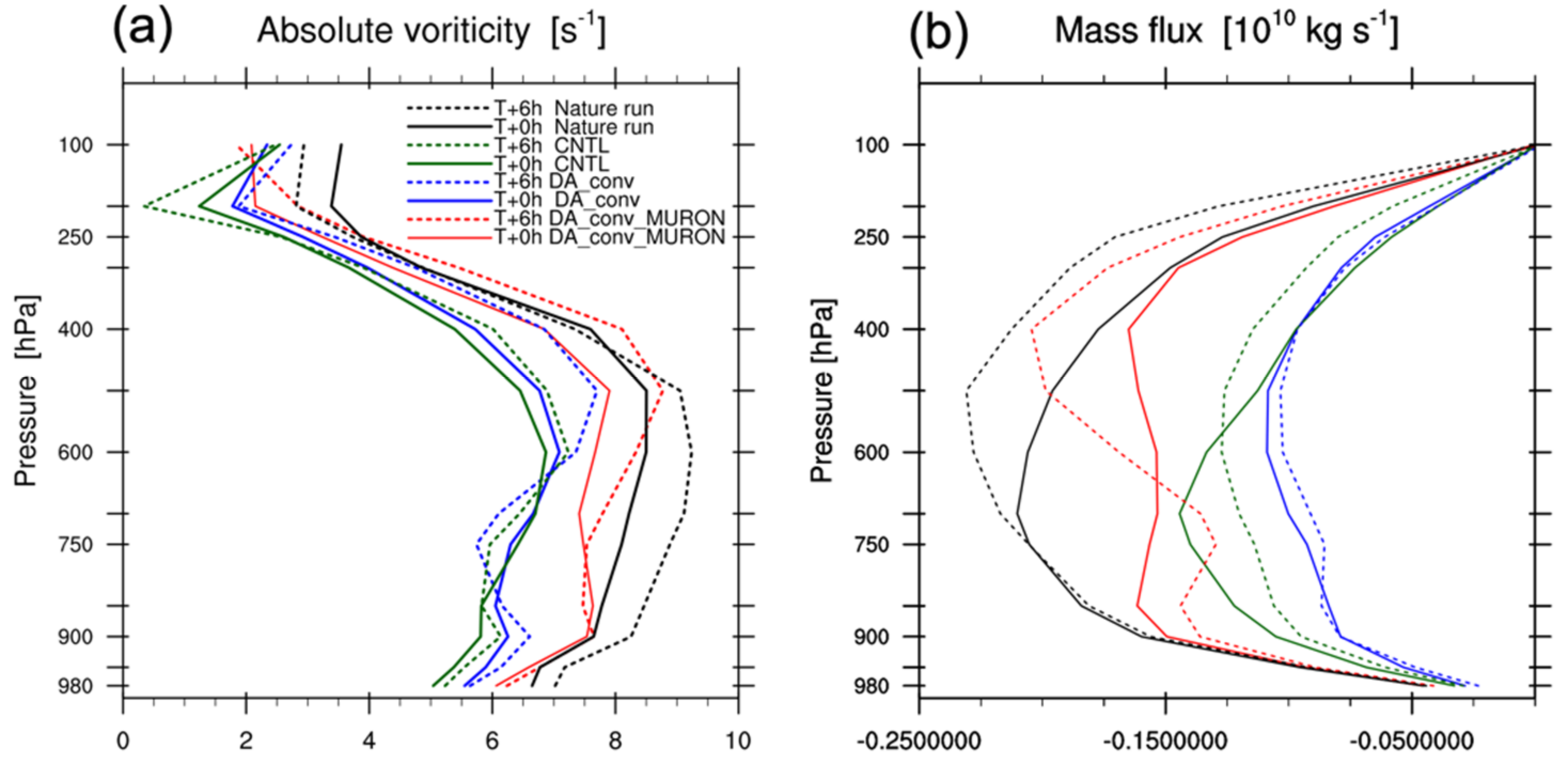
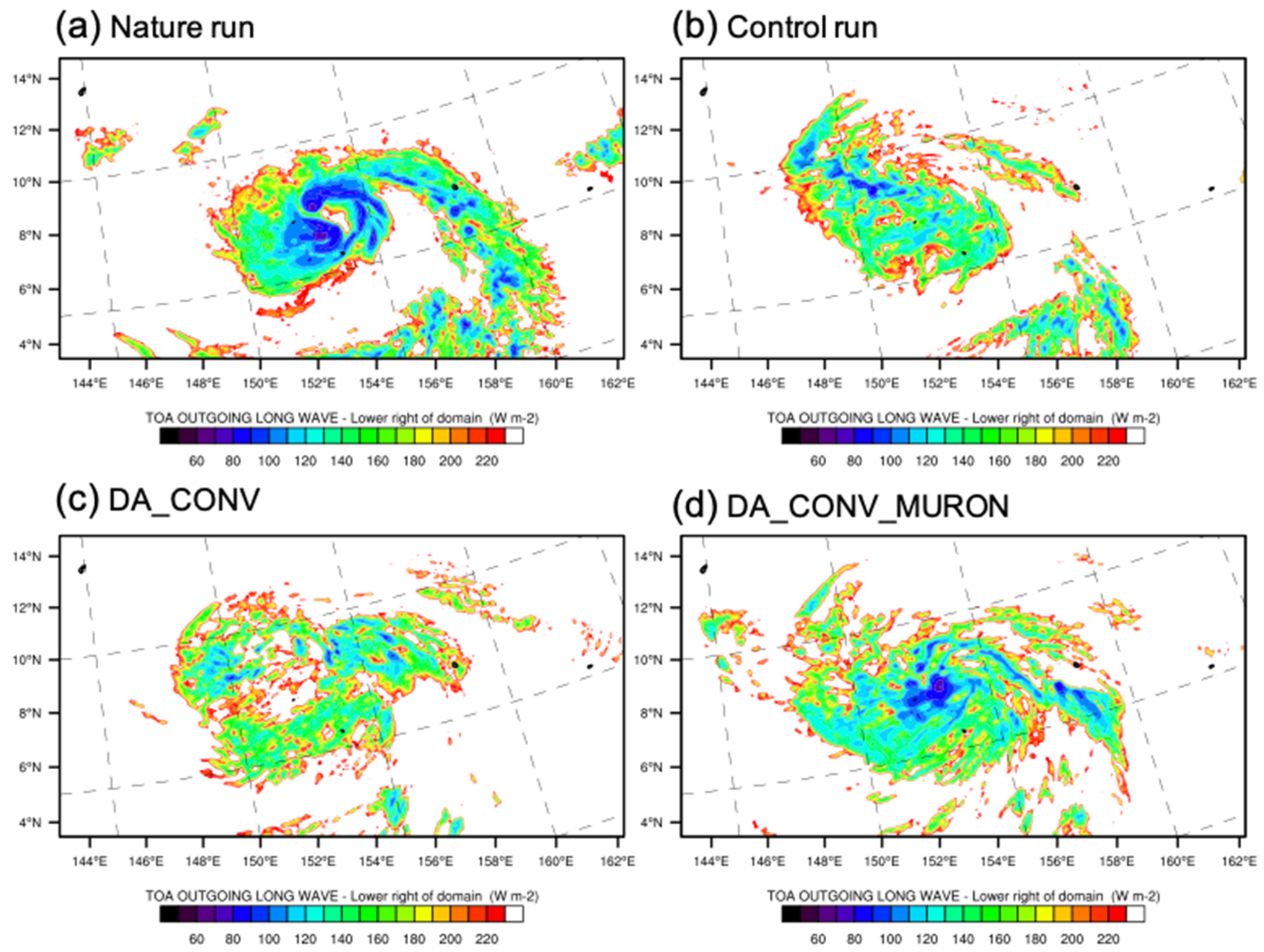
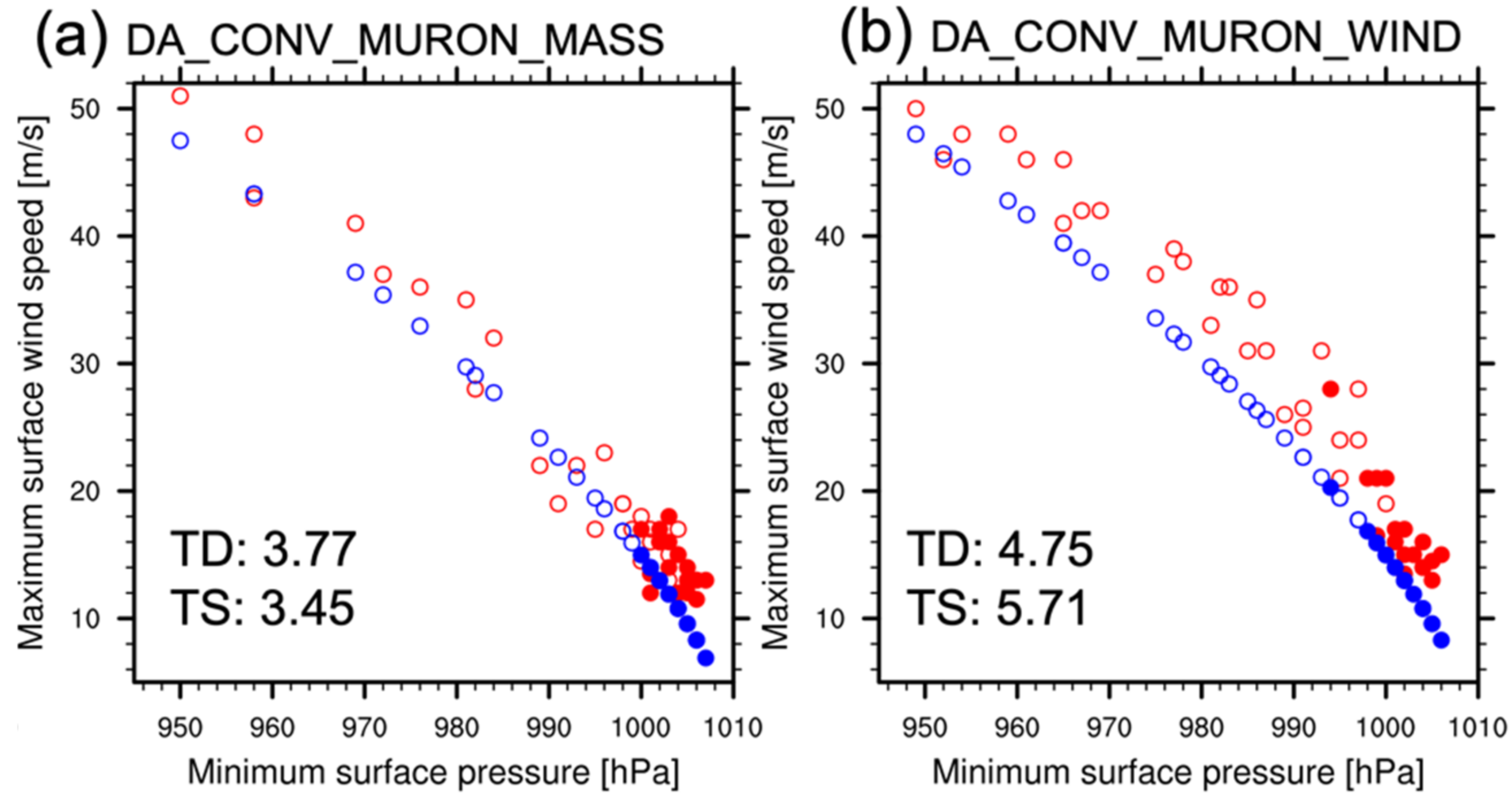
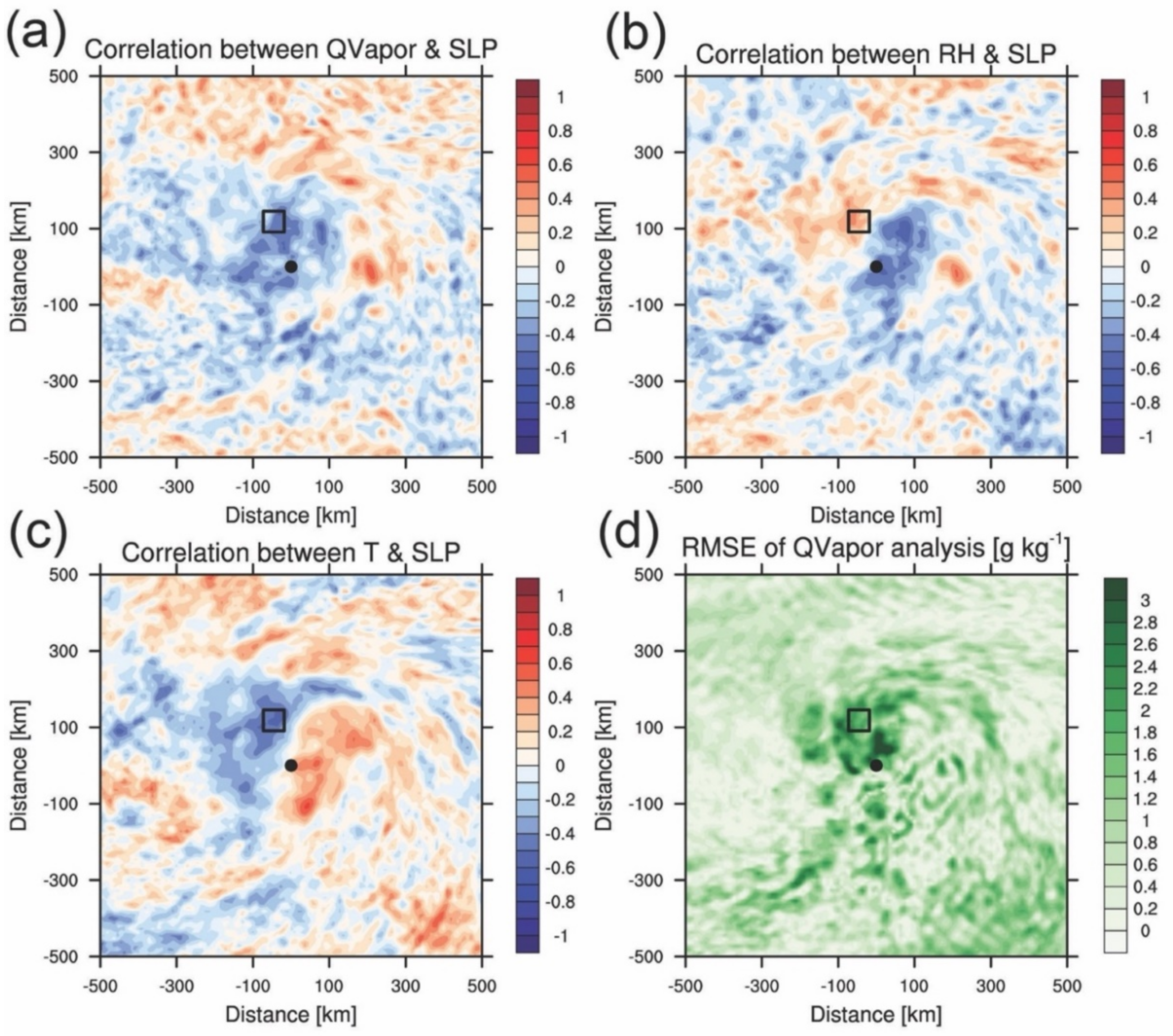
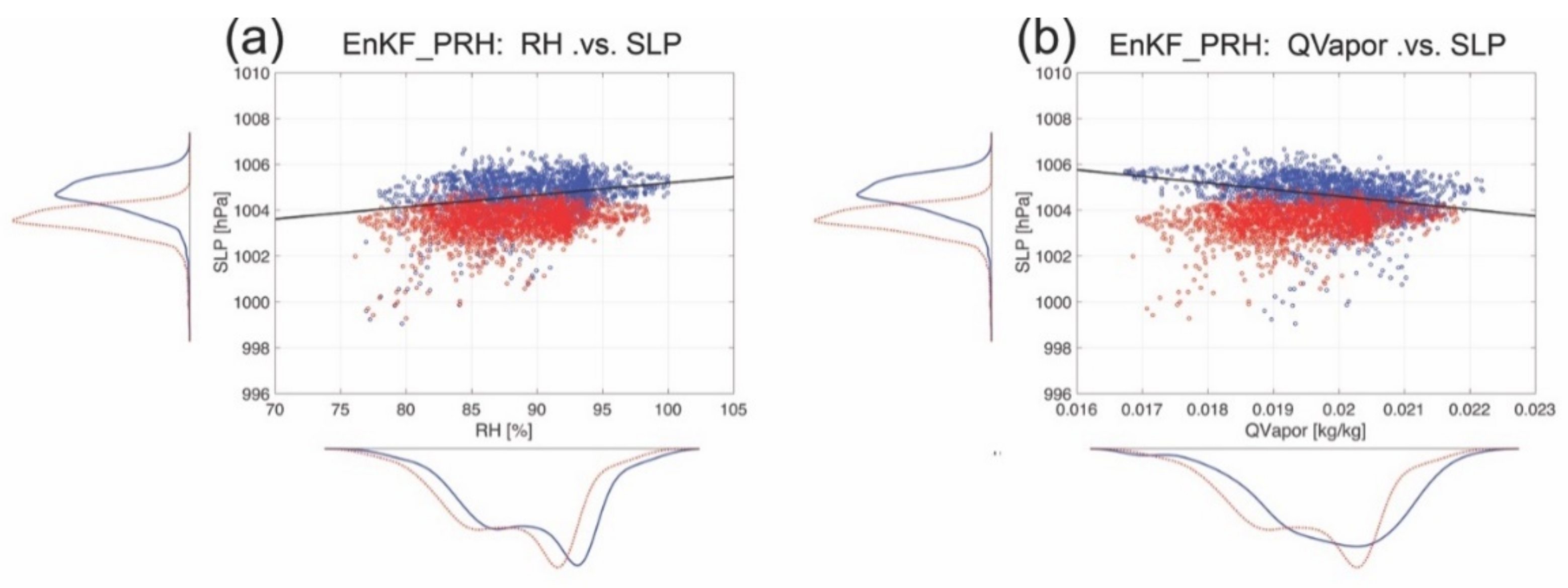
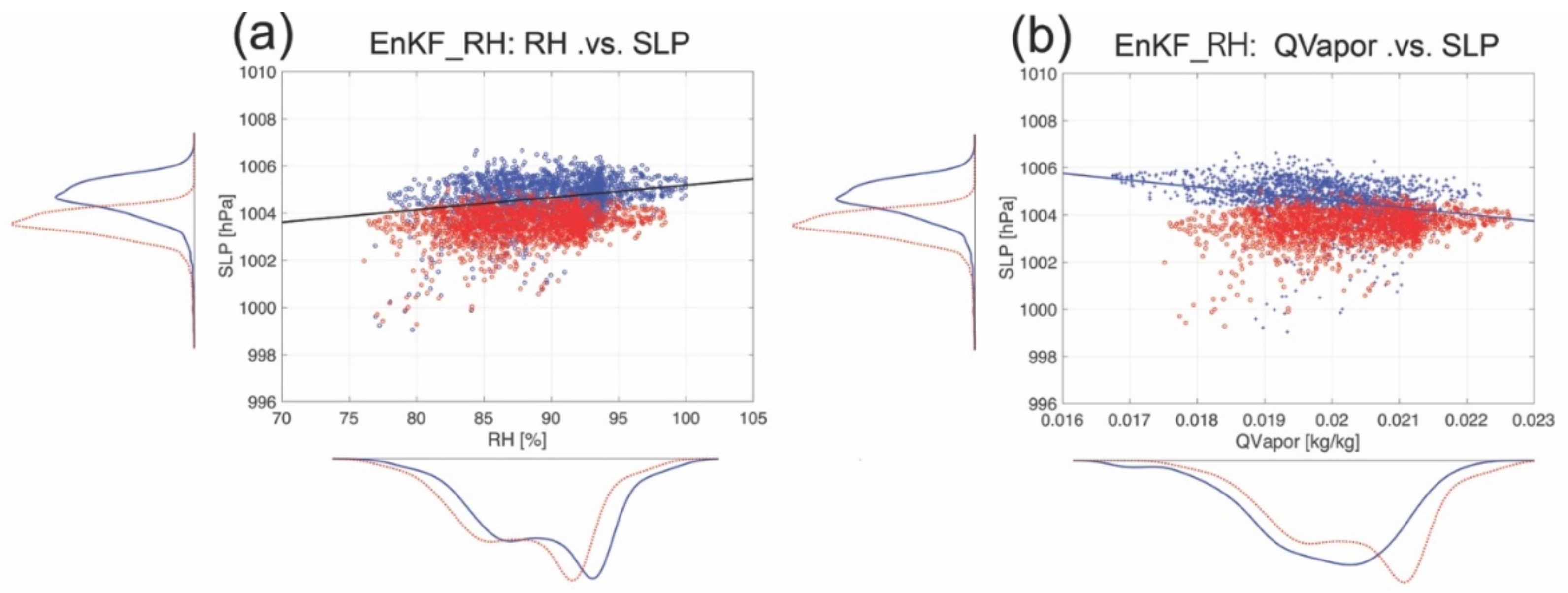

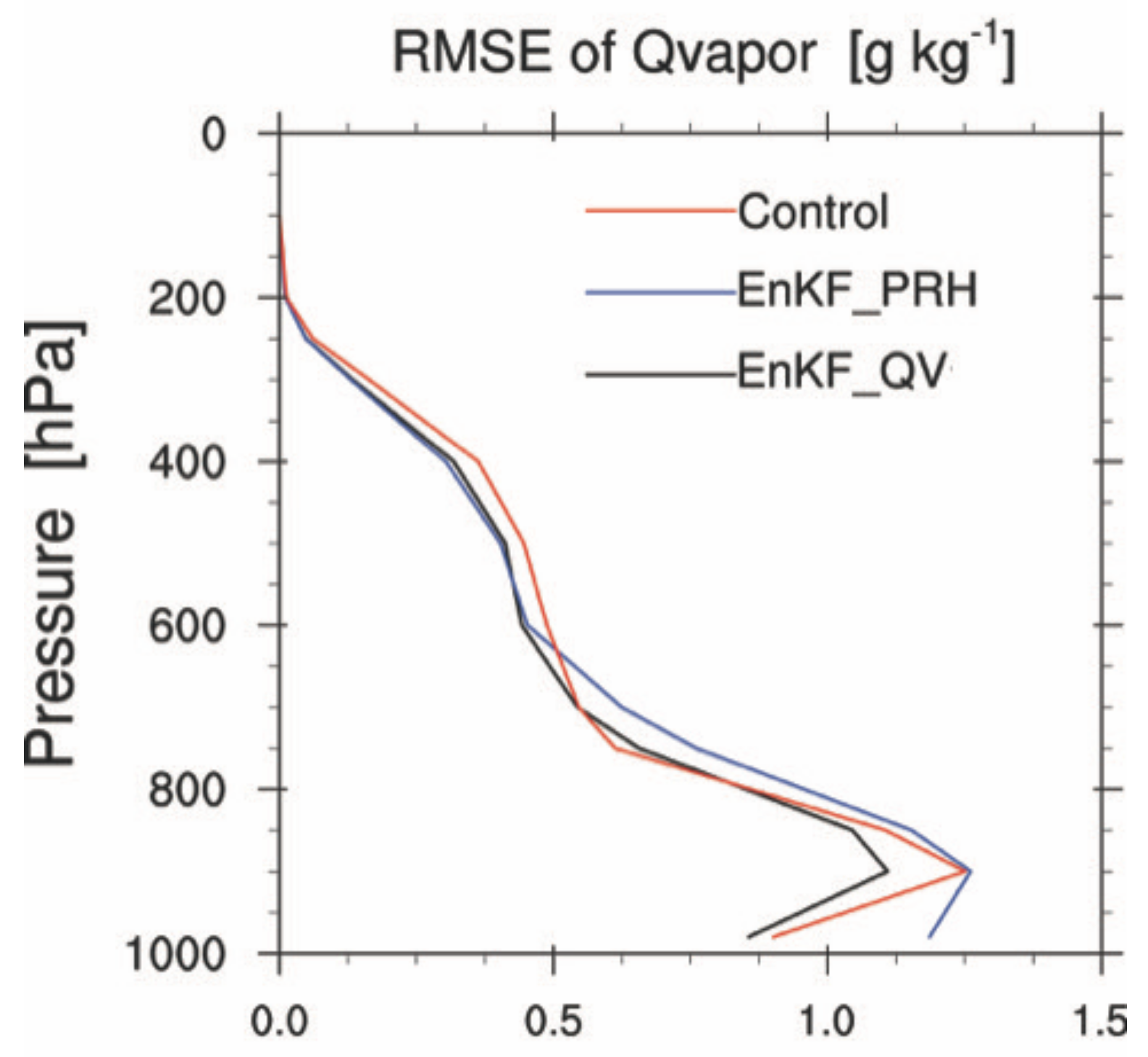
| GSI_R | MURON_R | Diagnosed Observation Error, RD | |
|---|---|---|---|
| Temperature | 0.92823 °C | 0.2 °C | 0.2 °C |
| Barometric pressure | 0.536 hPa | 1 hPa | 0.46 hPa |
| Specific humidity | 34.1 mg/kg | 20 mg/kg | 17.5 mg/kg |
| Zonal wind | 2.628 m/s | 2 m/s | 0.48 m/s |
| Meridional wind | 2.628 m/s | 2 m/s | 0.63 m/s |
| Nature Run | Control Run | DA_CONV | DA_CONV_MURON | |
|---|---|---|---|---|
| Domain | 27/9/3 km | 27/9 km | 27/9 km | 27/9 km |
| ICs/BCs | NCEP FNL | NCEP FNL | NCEP FNL/ Perturbed using statistic forecast error covariance | NCEP FNL/ Perturbed using statistic forecast error covariance |
| Physics parameterization | WDM6 | Lin | Lin | Lin |
| Kain-Fritsch (only for D1 and D2), None (D3) | Kain-Fritsch (D1, D2) | Kain-Fritsch (D1, D2) | Kain-Fritsch (D1, D2) | |
| YSU | MYJ | MYJ | MYJ | |
| Initialization | FDDA | no | no | no |
| Ocean cooling | Mixed layer model | no | no | no |
| Data assimilation | no | no | EnKF Conventional observations | EnKF Conventional, MURON observations |
| Forecast time | 00 UTC 02~ 00 UTC 8 November (144 h) | 00 UTC 03~ 00 UTC 8 November (120 h) | 00 UTC 03~ 00 UTC 8 November (120 h) | 00 UTC 03~ 00 UTC 8 November (120 h) |
Publisher’s Note: MDPI stays neutral with regard to jurisdictional claims in published maps and institutional affiliations. |
© 2022 by the authors. Licensee MDPI, Basel, Switzerland. This article is an open access article distributed under the terms and conditions of the Creative Commons Attribution (CC BY) license (https://creativecommons.org/licenses/by/4.0/).
Share and Cite
Kay, J.; Wang, X.; Yamamoto, M. An Observing System Simulation Experiment (OSSE) to Study the Impact of Ocean Surface Observation from the Micro Unmanned Robot Observation Network (MURON) on Tropical Cyclone Forecast. Atmosphere 2022, 13, 779. https://doi.org/10.3390/atmos13050779
Kay J, Wang X, Yamamoto M. An Observing System Simulation Experiment (OSSE) to Study the Impact of Ocean Surface Observation from the Micro Unmanned Robot Observation Network (MURON) on Tropical Cyclone Forecast. Atmosphere. 2022; 13(5):779. https://doi.org/10.3390/atmos13050779
Chicago/Turabian StyleKay, Junkyung, Xuguang Wang, and Masaya Yamamoto. 2022. "An Observing System Simulation Experiment (OSSE) to Study the Impact of Ocean Surface Observation from the Micro Unmanned Robot Observation Network (MURON) on Tropical Cyclone Forecast" Atmosphere 13, no. 5: 779. https://doi.org/10.3390/atmos13050779
APA StyleKay, J., Wang, X., & Yamamoto, M. (2022). An Observing System Simulation Experiment (OSSE) to Study the Impact of Ocean Surface Observation from the Micro Unmanned Robot Observation Network (MURON) on Tropical Cyclone Forecast. Atmosphere, 13(5), 779. https://doi.org/10.3390/atmos13050779





